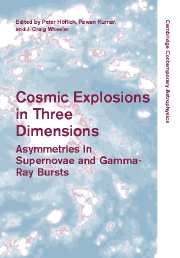Book contents
- Frontmatter
- Contents
- Part I Introduction
- Part II Supernovae: Observations Today
- Part III Theory of Thermonuclear Supernovae
- Part IV Theory of Core Collapse Supernovae
- 22 Rotation in core collapse progenitors: single and binary stars
- 23 Large scale convection and the convective supernova mechanism
- 24 Topics in core-collapse supernova-theory
- 25 MHD supernova jets: the missing link
- 26 Effects of super-strong magnetic fields in a core collapse supenova
- 27 Non-radial instability of stalled accretion shocks: advective-acoustic cycle
- 28 Asymmetry effects in hypernovae
- 29 Stellar abundances: the r-process and supernovae
- Part V Magnetars, N-Stars, Pulsars
- Part VI Gamma-ray Bursts
- Part VII Conference Summary
- References
28 - Asymmetry effects in hypernovae
Published online by Cambridge University Press: 11 August 2009
- Frontmatter
- Contents
- Part I Introduction
- Part II Supernovae: Observations Today
- Part III Theory of Thermonuclear Supernovae
- Part IV Theory of Core Collapse Supernovae
- 22 Rotation in core collapse progenitors: single and binary stars
- 23 Large scale convection and the convective supernova mechanism
- 24 Topics in core-collapse supernova-theory
- 25 MHD supernova jets: the missing link
- 26 Effects of super-strong magnetic fields in a core collapse supenova
- 27 Non-radial instability of stalled accretion shocks: advective-acoustic cycle
- 28 Asymmetry effects in hypernovae
- 29 Stellar abundances: the r-process and supernovae
- Part V Magnetars, N-Stars, Pulsars
- Part VI Gamma-ray Bursts
- Part VII Conference Summary
- References
Summary
Abstract
The basic explosion mechanisms of core-collapse supernovae (SNe) have not been clarified yet. The discovery of hypernovae with the isotropic kinetic energy (E) E51 ≡ E ∕ 1051 ergs ≳ 5-10 brought us a new light on this issue. Observational properties of hypernovae indicate that asymmetry may play an important role in the explosion. We discuss two classes of asymmetry effects related to hypernovae. (1) Effects of asymmetric ejecta on observed properties. Interpreting (late phase) optical light curves and spectra of hypernovae suggests that these objects are aspherical in nature. (2) Effects of asymmetric bipolar explosions on nucleosynthetic yields. An aspherical bipolar explosion provides high-velocity Fe-rich materials and low-velocity O-rich materials, which are in agreement with the observations. The unique yields of the bipolar explosions, e.g., enhanced (Zn, Co)/Fe and suppressed (Mn, Cr)/Fe, can account for the peculiar abundance patterns of extremely metal-poor stars, suggesting that they could have significantly contributed to the early Galactic chemical evolution.
Properties of hypernovae
Type Ic Hypernova SN 1998bw was probably linked to GRB 980425 (Galama et al. 1998), thus establishing for the first time a connection between gamma-ray bursts (GRBs) and core-collapse SNe. However, SN 1998bw was exceptional for a SN Ic: it was as luminous at peak as a SN Ia, indicating that it synthesized ∼0.5 M⊙ of 56Ni, and its isotropic E was estimated as E51 ≳ 30 (Iwamoto et al. 1998; Woosley, Eastman, & Schmidt 1999; see, however, Höflich, Wheeler, & Wang. 1999 for a different interpretation).
- Type
- Chapter
- Information
- Cosmic Explosions in Three DimensionsAsymmetries in Supernovae and Gamma-Ray Bursts, pp. 244 - 254Publisher: Cambridge University PressPrint publication year: 2004



